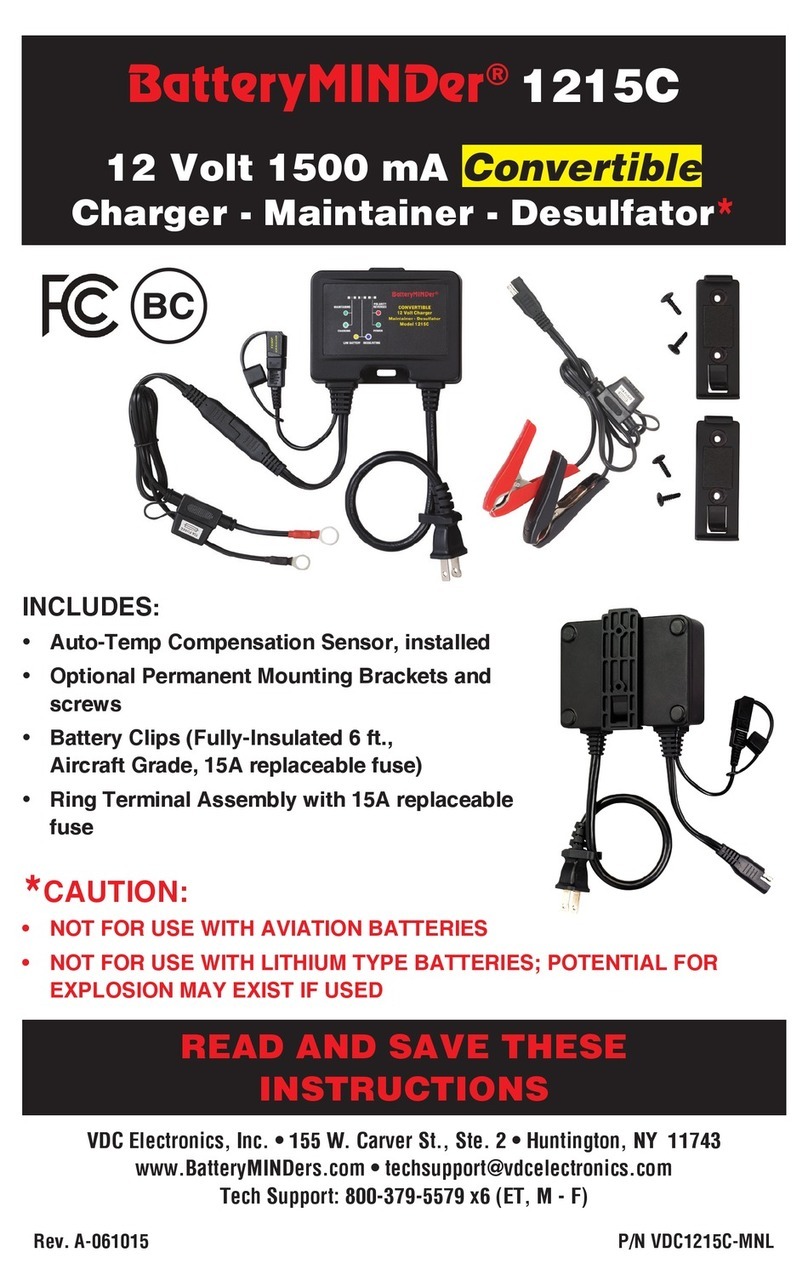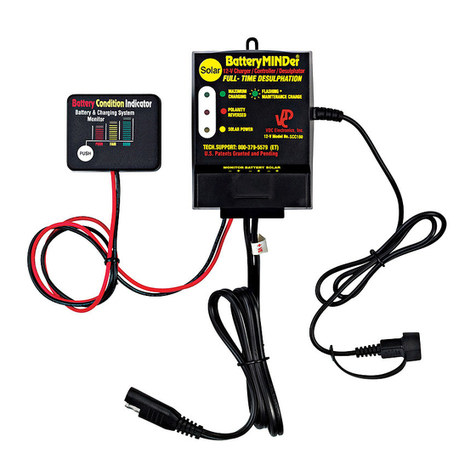BatteryMINDer BatteryMINDer 36271 User manual

Rev. D-120913 P/N VDC36271/48021-MNL
READ AND SAVE THESE
INSTRUCTIONS
VDC Electronics, Inc. •155 W. Carver St., Ste. 2 • Huntington, NY 11743
BatteryMINDer®
36-Volt 36271 and 48-Volt 48021
Battery Maintainer-Desulfators
INSTRUCTION MANUAL*
All Models Include:
• ATS Temperature Sensor (installed)
• Ring Terminals with 15A Fuse
• EZC-01 EZ Connector + Mounting Screws
• Designed to be used with your vehicle’s “stock-bulk” charger.
The BatteryMINDer takes over when the original supplied charger
shuts off. See the accompanying addendum for more details.
• NOT for use with Aviation-type batteries

BatteryMINDer® Models 36271 & 48021
Rev. D-120913 Page 2 P/N VDC36271/48021-MNL
Glossary of Terms
• Maintain a battery
BatteryMINDer ensures batteries are truly fully charged and will likely
continue improving the condition of the battery to the fullest extent
possible.
• Rested
A battery that has been as fully charged as possible and left disconnected
from charger or any type load overnight.
• Specific Gravity
One of the key parameters of battery operation is the specific gravity of the
electrolyte. Specific gravity is the ratio of the weight of a solution to the
weight of an equal volume of water at a specified temperature. Specific
gravity is used as an indicator of the state of charge of a cell or battery.
• Sulfation
Occurs when the battery sits for long periods of time and the electrolyte
solution begins to break down. Sulfur in the solution leaches from the
electrolyte, sticking to the lead plates as converted lead sulfuric crystals.
Table Of Contents
Required Safety Instructions . . . . . . . . . . . . . . . . . . . . . . . . . . . . 3
Preparing to Charge . . . . . . . . . . . . . . . . . . . . . . . . . . . . . . . . 5
Charger Location . . . . . . . . . . . . . . . . . . . . . . . . . . . . . . . . . 5
DC Connection Precautions . . . . . . . . . . . . . . . . . . . . . . . . . . . . 5
Qualifying Your Battery . . . . . . . . . . . . . . . . . . . . . . . . . . . . . . 7
Testing a Filler Cap Lead-Acid Battery . . . . . . . . . . . . . . . . . . . . . . . 7
Specific Gravity – Capacity Table. . . . . . . . . . . . . . . . . . . . . . . . . . 9
Testing With a Hot/Cold Calibrated Hydrometer Tester . . . . . . . . . . . . . . . 9
Testing A Sealed, AGM or Flooded (Wet-Cell) Lead Acid Battery . . . . . . . . . . 9
Use a Digital Voltmeter Only . . . . . . . . . . . . . . . . . . . . . . . . . . . . 9
OCV/Full Capacity Table . . . . . . . . . . . . . . . . . . . . . . . . . . . . . .10
Unit Labels . . . . . . . . . . . . . . . . . . . . . . . . . . . . . . . . . . . .11
Simplified Operating Instructions . . . . . . . . . . . . . . . . . . . . . . . . .12
Common Features . . . . . . . . . . . . . . . . . . . . . . . . . . . . . . . . .13
Battery Condition Table . . . . . . . . . . . . . . . . . . . . . . . . . . . . . .14
LED Status Table. . . . . . . . . . . . . . . . . . . . . . . . . . . . . . . . . .14
Detailed Operating Instructions . . . . . . . . . . . . . . . . . . . . . . . . . .15
Multi-Battery Configuration . . . . . . . . . . . . . . . . . . . . . . . . . . . .18
Charge and Float Voltages at Various Temperature Ranges . . . . . . . . . . . . .19
Maintaining Multiple Batteries . . . . . . . . . . . . . . . . . . . . . . . . . . 20
Troubleshooting . . . . . . . . . . . . . . . . . . . . . . . . . . . . . . . . . .21
For Repair or Replacement / Registration . . . . . . . . . . . . . . . . . . . . 23
Guarantee / Warranty . . . . . . . . . . . . . . . . . . . . . . . . . . . . . . .24

BatteryMINDer® Models 36271 & 48021
Rev. D-120913 Page 3 P/N VDC36271/48021-MNL
REQUIRED SAFETY INSTRUCTIONS
WARNING
READ AND FULLY UNDERSTAND BEFORE OPERATING
Contact VDC Electronics if uncertain about
any settings or operation.
TO REDUCE THE RISK OF FIRE, ELECTRIC SHOCK, OR
INJURY TO PERSON, OBSERVE THE FOLLOWING:
1. SAVE THESE INSTRUCTIONS
2. This manual contains important safety and operating instructions for
BatteryMINDer Models 36271 and 48021.
3. Do not expose charger to rain or snow.
4. Use of an attachment not recommended or sold by VDC Electronics
may result in a risk of fire, electric shock, or injury to persons.
5. To reduce risk of damage to electric plug and cord, pull by plug rather
than cord when disconnecting charger.
6. An extension cord should not be used unless absolutely necessary.
Use of improper extension cord could result in a risk of fire and electric
shock. If an extension cord must be used, make sure:
• That pins on plug of extension cord are the same number, size, and
shape as those of plug on charger;
• That extension cord is properly wired and in good electrical condition;
and
• That wire size is large enough for ac ampere rating of charger as
specified in Table below.
7. Do not operate charger with damaged cord or plug – replace the cord
or plug immediately.
8. Do not operate charger if it has received a sharp blow, been dropped,
or otherwise damaged in any way; call VDC Electronics Tech
Recommended minimum AWG size for
extension cords for battery chargers
AC input rating,
amperesa
AWG size of cord
Equal to
or
greater
than
But less
than
Length of cord, feet (m)
25
(7.6)
50
(15.2)
100
(30.5)
150
(45.6)
0 2 18 18 18 16
aIf the input rating of a charger is given in watts rather than in amperes, the
corresponding ampere rating is to be determined by dividing the wattage rating by
the voltage rating - for example: 1250 watts/125 volts = 10 amperes

BatteryMINDer® Models 36271 & 48021
Rev. D-120913 Page 4 P/N VDC36271/48021-MNL
Support Dept. 800.379.5579 x6 (ET) for advice.
9. Do not disassemble charger; call VDC Electronics Tech Support
Dept. 800.379.5579 x6 (ET) for advice when service or repair is
required. Incorrect reassembly may result in a risk of electric shock
or fire.
10. To reduce risk of electric shock, unplug charger from outlet before
attempting any maintenance or cleaning. Turning off controls will not
reduce this risk.
11. WARNING – RISK OF EXPLOSIVE GASES
a. WORKING IN VICINITY OF A LEAD-ACID BATTERY IS
DANGEROUS. BATTERIES GENERATE EXPLOSIVE GASES
DURING NORMAL BATTERY OPERATION. FOR THIS
REASON, IT IS OF UTMOST IMPORTANCE THAT YOU
FOLLOW THE INSTRUCTIONS EACH TIME YOU USE THE
CHARGER.
b. To reduce risk of battery explosion, follow these instructions and
those published by manufacturer of any equipment you intend to
use in vicinity of battery. Review cautionary marking on these
products and on engine.
12. PERSONAL PRECAUTIONS
a. Consider having someone close enough by to come to your aid
when you work near a lead-acid battery.
b. Have plenty of fresh water and soap nearby in case battery acid
contacts skin, clothing, or eyes.
c. Wear complete eye protection and clothing protection. Avoid
touching eyes while working near battery.
d. If battery acid contacts skin or clothing, wash immediately with
soap and water. If acid enters eye, immediately flood eye with
running cold water for at least 10 minutes and get medical
attention immediately.
e. NEVER smoke or allow a spark or flame in vicinity of battery or
engine.
f. Be extra cautious to reduce risk of dropping a metal tool onto
battery. It might spark or short-circuit battery or other electrical
part that may cause explosion.
g. Remove personal metal items such as rings, bracelets, necklaces,
and watches when working with a lead-acid battery. A lead-acid
battery can produce a short-circuit current high enough to weld a
ring or the like to metal, causing a severe burn.
h. Use charger for charging a LEAD-ACID battery only. It is not
intended to supply power to a low voltage electrical system other
than in a starter-motor application. Do not use battery charger

BatteryMINDer® Models 36271 & 48021
Rev. D-120913 Page 5 P/N VDC36271/48021-MNL
for charging dry-cell batteries that are commonly used with
home appliances. These batteries may burst and cause injury to
persons and damage to property.
i. NEVER charge a frozen battery or a battery at a temperature
above 123° F.
13. PREPARING TO CHARGE
a. If necessary to remove battery from vehicle to charge, always
remove grounded terminal from battery first. Make sure all
accessories in the vehicle are off, so as not to cause an arc.
b. Be sure area around battery is well ventilated while battery is
being charged.
c. Clean battery terminals. Be careful to keep corrosion from
coming in contact with eyes.
d. Add distilled water in each cell until battery acid reaches level
specified by battery manufacturer. Do not overfill. For a battery
without removable cell caps, such as valve regulated lead acid
batteries, carefully follow manufacturer’s recharging instructions.
e. Study all battery manufacturer’s specific precautions while
charging and recommended rates of charge.
f. Determine voltage of battery by referring to car owner’s manual
and make sure it matches output rating of battery charger.
14. CHARGER LOCATION
a. Locate charger as far away from battery as DC cables permit.
b. Never place charger directly above battery being charged; gases
from battery will corrode and damage charger.
c. Never allow battery acid to drip on charger when reading
electrolyte specific gravity or filling battery.
d. Do not operate charger in a closed-in area or restrict ventilation
in any way.
e. Do not set a battery on top of charger.
f. Always mount units in vertical position with cord sets exiting
downward to ensure weather tight integrity. Unit must be mounted
in this manner to ensure long term trouble free life including
weatherproof integrity. Mounting in any other manner or
using un-mounted (parallel to ground) except indoors may
cause unit to fail due to water intrusion that is unable to drain
correctly to avoid damage.
15. DC CONNECTION PRECAUTIONS
a. Connect and disconnect DC output clips only after setting any
charger switches to “off” position and removing ac cord from
electric outlet. Never allow clips to touch each other.
b. Attach clips to battery and chassis as indicated
Other manuals for BatteryMINDer 36271
1
This manual suits for next models
1
Table of contents
Other BatteryMINDer Batteries Charger manuals
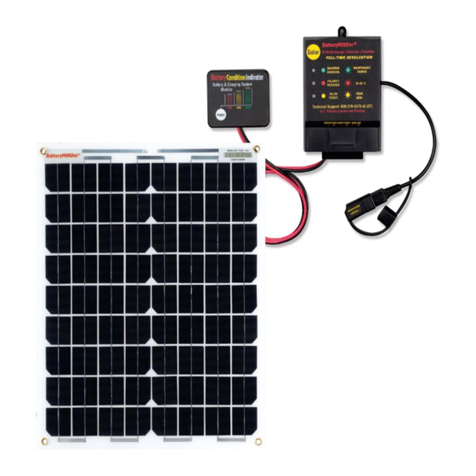
BatteryMINDer
BatteryMINDer SCC1224 User manual
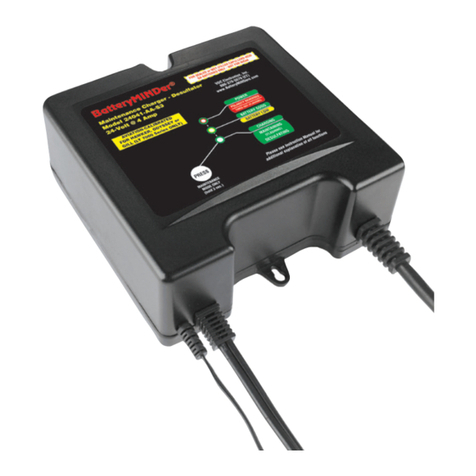
BatteryMINDer
BatteryMINDer 24041-AA Series User manual
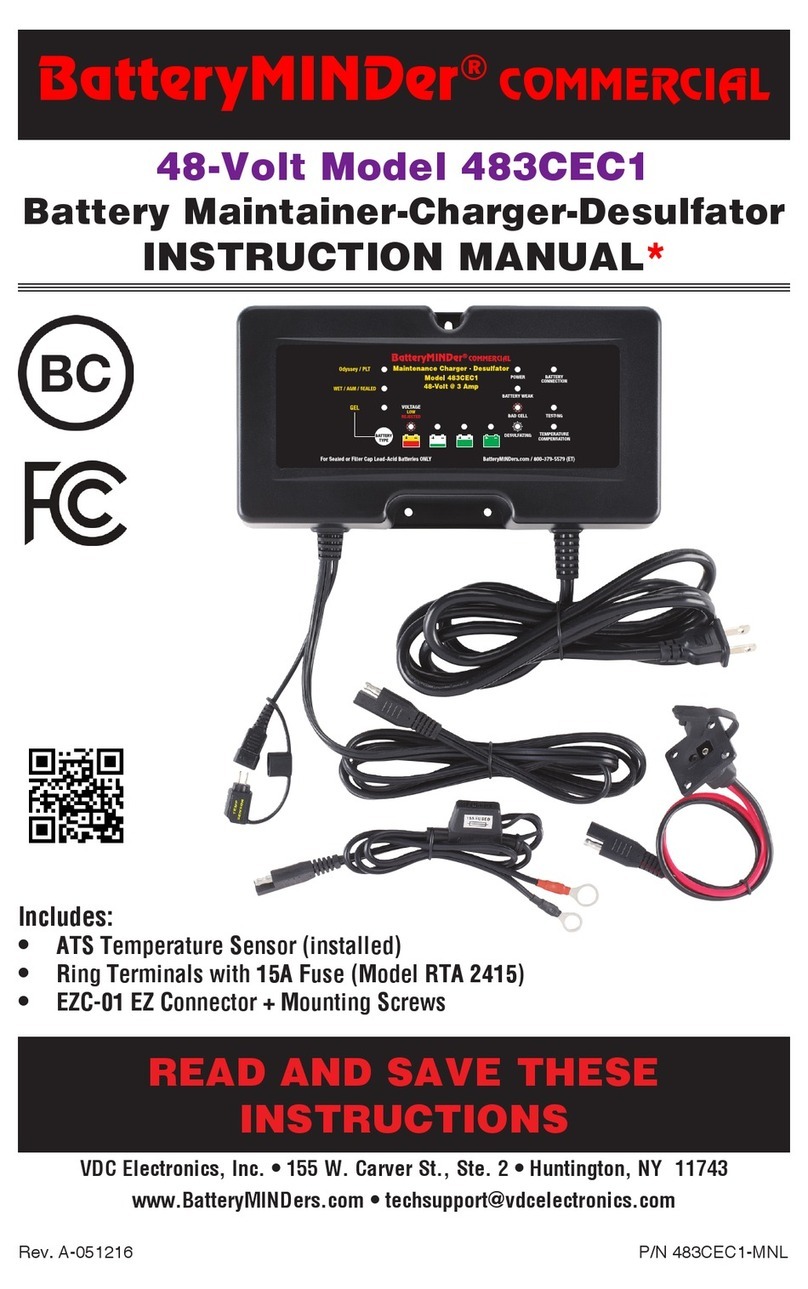
BatteryMINDer
BatteryMINDer 483CEC1 User manual
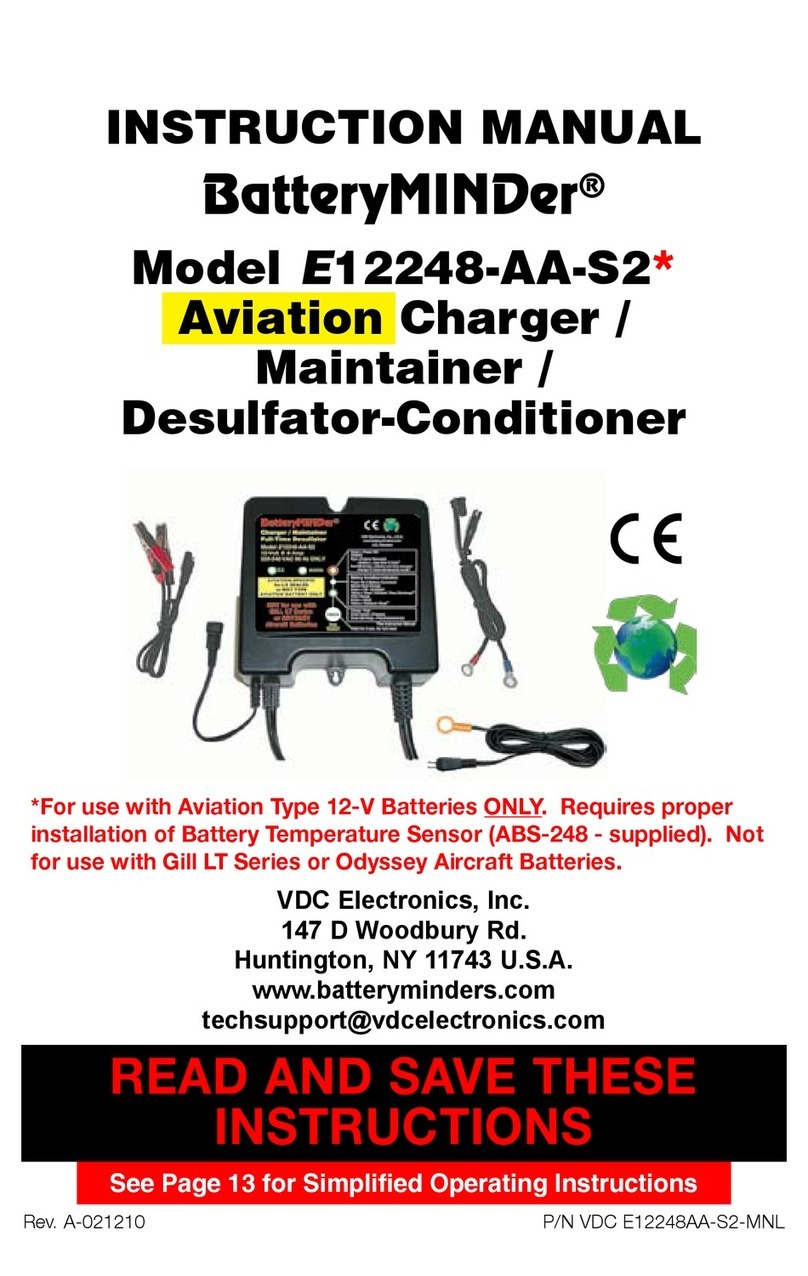
BatteryMINDer
BatteryMINDer E12248-AA-S2 User manual
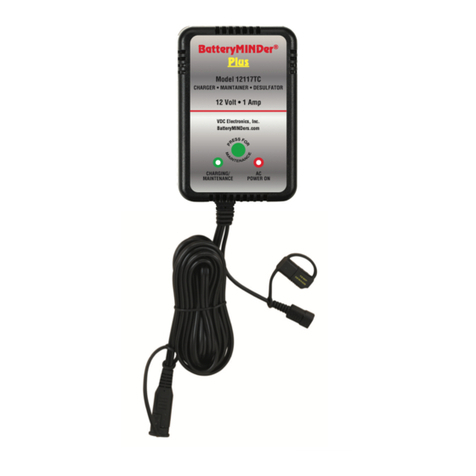
BatteryMINDer
BatteryMINDer Plus 12117TC User manual
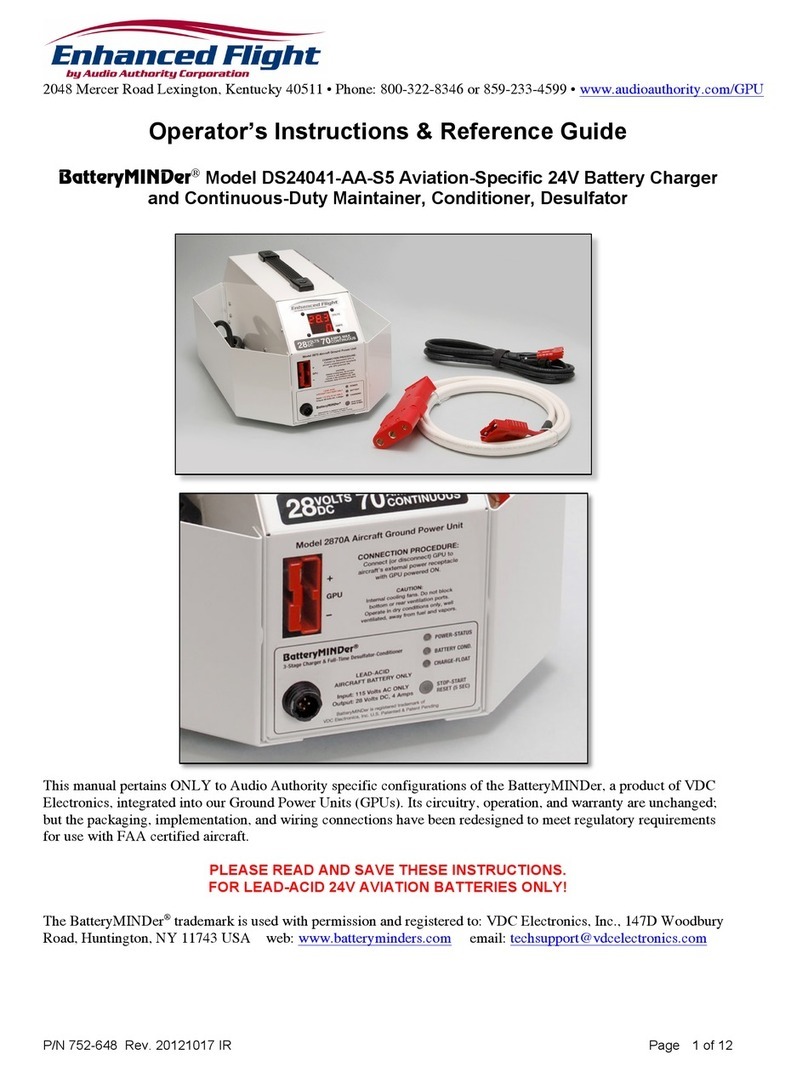
BatteryMINDer
BatteryMINDer DS24041-AA-S5 Specifications
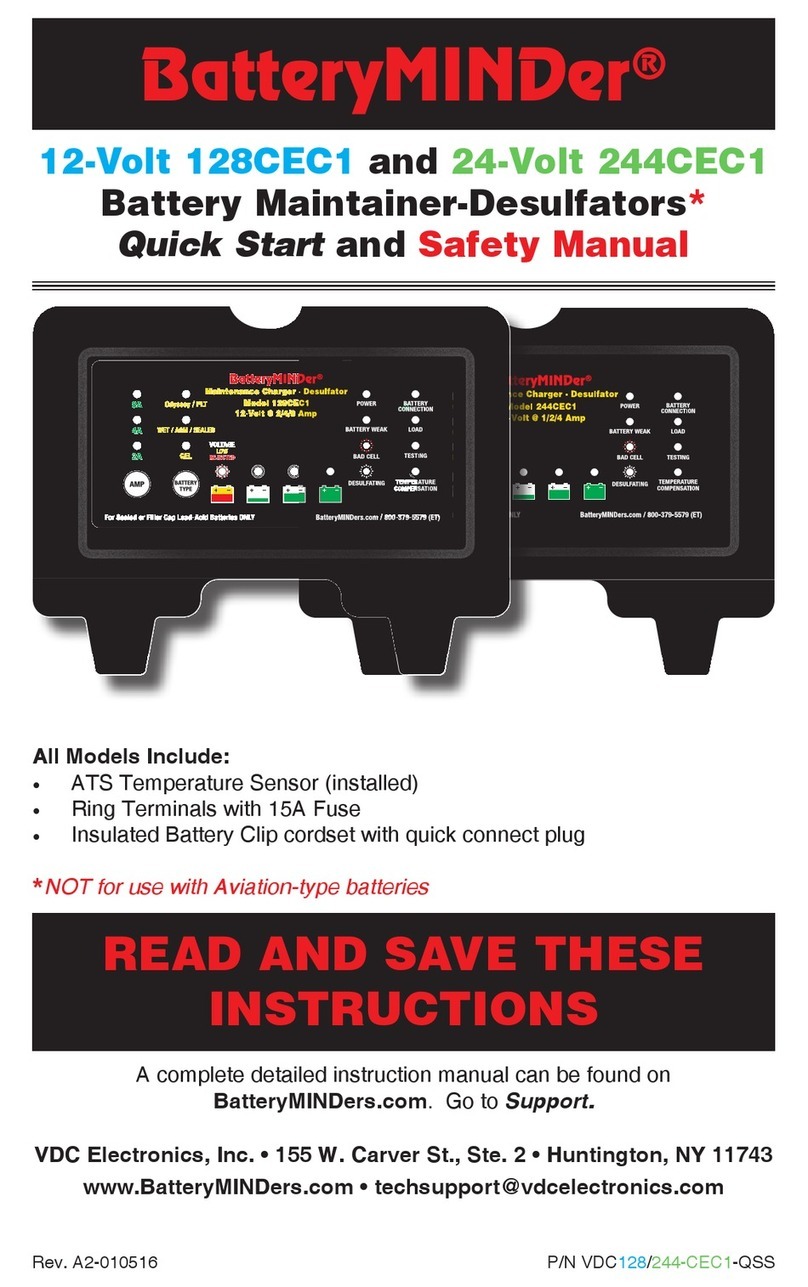
BatteryMINDer
BatteryMINDer 128CEC1 User manual
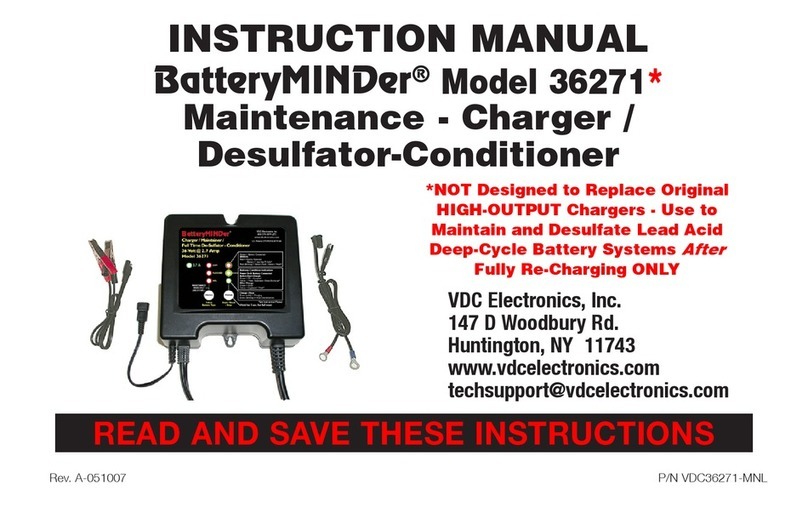
BatteryMINDer
BatteryMINDer BatteryMINDer 36271 User manual
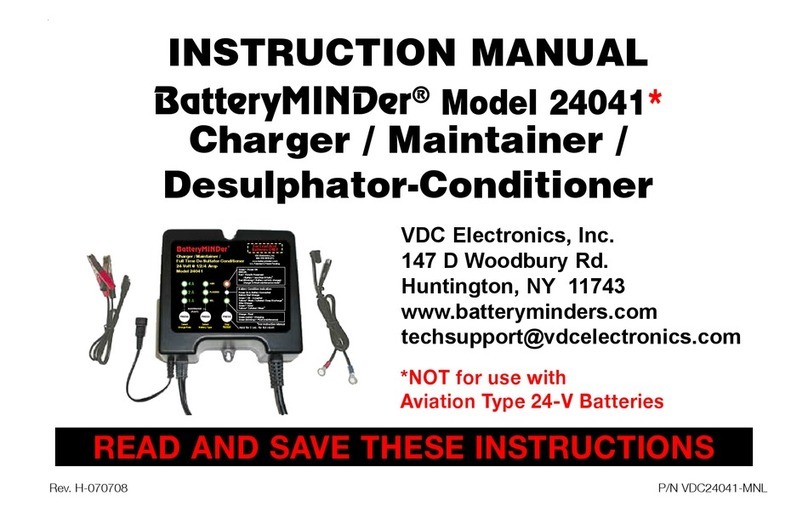
BatteryMINDer
BatteryMINDer 24041 User manual
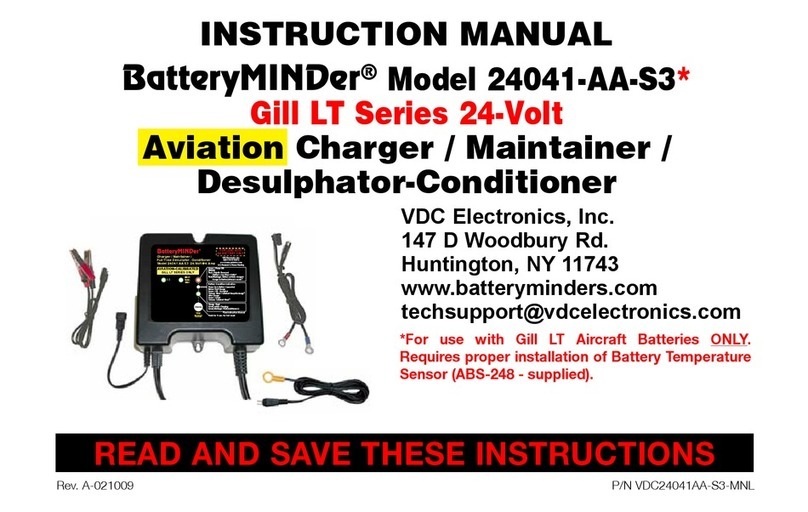
BatteryMINDer
BatteryMINDer 24041-AA-S3 User manual
